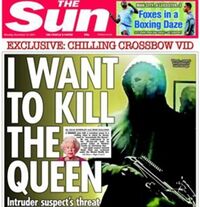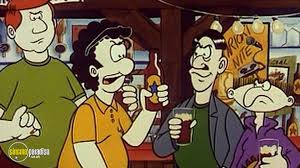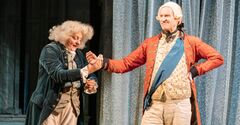Windsor Castle
Windsor Castle is a castle in England and the home of British monarch King Charles III and the rest of the ruling royal family. Windsor Castle is in the county of Berkshire, which results in it sometimes being called "Royal Berkshire" and provides a tourist alternative to scruffy downtown Reading.
It has been continuously occupied for longer than any other palace in Europe (to which Britain claims to no longer belong). This is because none of the various assaults on Britain have been so severe as to induce the royals to seek safer accommodations (though time will tell about the rowboats from France).
Etymology
Windsor Castle takes its name from the fact that its residents — ruling monarch King Charles III and his family, such as it is — are the House of Windsor. Except the one the royals, taking after Jeb Bush's relatives, call "the little dark one"; she is no longer invited at all.
Five hundred years ago, the castle would have been called Stuart Castle. And since the sale of naming rights in the 2010s, it is officially known as the Tesco Castle.
If the valued reader is named Fred, he could go around stating that his house is the Fred Castle, which is true but a little pompous. But Nashua, New Hampshire would not thereby become "Royal Nashua".
Financing
The castle has enough lavish state apartments, built of Bagshot Heath, to make a hobbit blush. After neglect during the 18th century, a previous claimant to the name George III rebuilt the palace at colossal expense and loaded it with rococo and baroque furnishings — two words that have come to mean something outside any normal person's ability to understand.
The average British day-laborer pays the expenses for Windsor Castle. This inspires entertaining conversations dahn th' paab regarding why the nation needs such a castle, or even such a family.
History
Windsor Castle was laid out by William the Conqueror after the Norman conquest of 1066. It is a day's march (twenty miles) from London, allowing for easy reinforcements in a crisis, unless the crisis includes snipers and infantry.
Once built, the royals of the day refused to move there; they preferred to stay in Old Windsor at the palace of Edward the Confessor, as it was convenient to the office of Nathan the Chiropractor. The first king to make use of Windsor Castle was Henry (not yet referred to as Henry I), who celebrated Whitsuntide there in 1110 during a period in which most Englishmen would have celebrated his beheading instead. In 1121, Henry was married to Adela there, who was impressed even though the southern keep was sinking into the ground so fast that the main hallway featured go-kart races. Starting in 1165, Henry II shored the place up, having a foundation laid, this time.
In 1214-15, King John holed up there during the barons' revolt and used the castle as the base of negotiations. The castle did fine, but the negotiations were a rout; the barons forced him to sign the Magna Carta and put England on its way to civilization.
In 1216, Windsor Castle was again besieged and damaged. Henry III spent like a drunken Congressman to repair the damage, strengthen the defences, and provide spare rooms for all of his BFFs, only to see them bicker about who would get the ones with the windows. In 1344, Edward III established the Order of the Round Table, obviating the continual arguments about who should sit where, and probably started building a round room to house it. However, he abandoned this effort for unclear reasons, consigning it to the realm of fiction, and instead established the Order of the Garter, which can be worn whilst sitting at tables of any shape.
Henry VIII enjoyed Windsor Castle, as it provided dozens of diversions from actually running the country, and was comfortably distant from the north of England (which rose up against him in 1536) and from plague-bound London. He built a terrace called the North Wharf with a fabulous view of the Thames, which is of no help to stevedores hauling off barges the merchandise that His Majesty ordered. The Wharf featured an outside staircase, which saved Henry almost as many steps as it would save an attacking army.
When the House of Windsor took over, their signature vanity made it inevitable that they would pick Windsor Castle to live in. Elizabeth I spent much of her time there, and had ten brass cannons installed, as there is never any telling whether the peasants will try to arm themselves and attack again. James I used the castle for his three pastimes: hunting, drinking, and watching William Shakespeare put on plays about the first two. Charles I had the place completely surveyed, and set the tone for future British government by ignoring all the experts' recommendations.
In 1642, when the English Civil War broke out, Windsor Castle became a handy place to hang out, avoid getting killed, and loot the chapel. The monarchy was restored in 1660 and Charles picked up where he left off, spending unprecedented amounts of the nation's wealth to gussy up the place further. It would be the showpiece of England — even though Charles was infatuated by all things French and stopped just short of installing a guillotine.
George I and II, by comparison, had little use for Windsor Castle, though they used the apartments to house widows and friends as a "grace", it being graceful for a monarch to give out things others have been bent over to fund. Around that time, ordinary citizens became curious to see the interior, which only took a small bribe to the castle-keeper. George III reversed this trend and threw his bags down at Windsor Castle, though his brother Henry would not move out and George mortifyingly had to sleep in the Queen's Lodge. Again, spending went through the roof, as the King's architectural tastes varied over time. So did the purpose of the castle, going from a place from which to govern to a place inside which to be confined after showing one of his several "relapses".
George IV ascended to the throne in 1820 and thought a wealthy nation needed an even more opulent castle for him to live in. Because of that Magna Carta thing, George was forced to beg Parliament for the funds, but they were as vain as he was and voted him the equivalent of £245 million, eventually ballooning to £817 million. Unfortunately, George hired architect Jeffry Wyatville and again ignored his advice, "preferring a blend of periods and styles". Windsor Castle thus became the epitome of what is now called Early Modern Mishmash. Elizabeth I called it home — but also called it "dull" and "prison-like", as George's blend comprised steel toilets, bunk beds, and bars on the doors.
In 1901, Edward VII became king and immediately modernised Windsor Castle with "enthusiasm and zest" and another ton of public funds. He rummaged through disused apartments and threw out "rubbishy old coloured pictures", most of them scrawled by His Majesty himself, which might prove problematic for his reign. Fortunately, though, Edward electrified the place and set up a car park and even an airstrip. George V continued this modernisation; even his wife Mary of Teck went High Teck. However, the Missus was infatuated by Avon figurines, Kewpie dolls not yet having been invented, and Windsor Castle's style was transformed to what we now call Kitsch.
Recent events

In 1992, a major fire broke out that destroyed more than 100 staterooms. Reconstruction ignited new public fury about how much the nation's miners and farmers would have to pay to indulge royal vanity. Elizabeth, whom the press called on to reach deeper into her own purse, settled the debate by opening Buckingham Palace to the public at certain times, and installing parking meters at Windsor.
On Christmas Day 2021, 19-year-old Jaswant Singh Chail climbed into the castle's gardens with a rope ladder. He was in full compliance with Britain's gun control laws, as he carried only a crossbow. He was arrested and sectioned (formerly known as "drawn and quartered") under the Mental Health Act. Though Scotland Yard says his motives are unclear, his blog post about assassinating the Queen sufficed to shut them up about Mental Health and trot out the Treason Act, to which he pleaded guilty. He was let go with a stern scolding, never to offend again.
Current state
King Charles III owns Windsor Castle in right of the Crown, which rarely expresses an opinion either way. Day-to-day management is by the Royal Household, though you'll never see a Prince or an Earl come close to picking up a mop. As of 2006, around 500 people were there, living, working, or simply paying admission and scampering upstairs so as not to have to leave at closing time.
| Featured version: 15 April 2023 | |
| This article has been featured on the main page. — You can vote for or nominate your favourite articles at Uncyclopedia:VFH. | |




